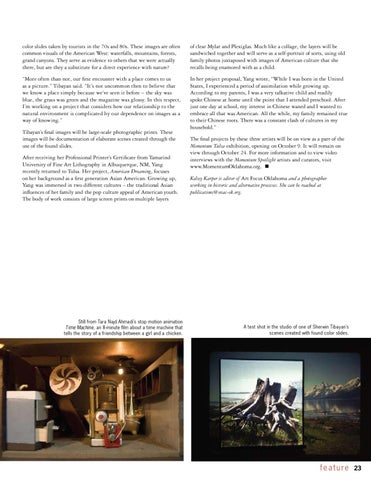color slides taken by tourists in the 70s and 80s. These images are often common visuals of the American West: waterfalls, mountains, forests, grand canyons. They serve as evidence to others that we were actually there, but are they a substitute for a direct experience with nature?
of clear Mylar and Plexiglas. Much like a collage, the layers will be sandwiched together and will serve as a self-portrait of sorts, using old family photos juxtaposed with images of American culture that she recalls being enamored with as a child.
“More often than not, our first encounter with a place comes to us as a picture.” Tibayan said. “It’s not uncommon then to believe that we know a place simply because we’ve seen it before – the sky was blue, the grass was green and the magazine was glossy. In this respect, I’m working on a project that considers how our relationship to the natural environment is complicated by our dependence on images as a way of knowing.”
In her project proposal, Yang wrote, “While I was born in the United States, I experienced a period of assimilation while growing up. According to my parents, I was a very talkative child and readily spoke Chinese at home until the point that I attended preschool. After just one day at school, my interest in Chinese waned and I wanted to embrace all that was American. All the while, my family remained true to their Chinese roots. There was a constant clash of cultures in my household.”
Tibayan’s final images will be large-scale photographic prints. These images will be documentation of elaborate scenes created through the use of the found slides. After receiving her Professional Printer’s Certificate from Tamarind University of Fine Art Lithography in Albuquerque, NM, Yang recently returned to Tulsa. Her project, American Dreaming, focuses on her background as a first generation Asian American. Growing up, Yang was immersed in two different cultures – the traditional Asian influences of her family and the pop culture appeal of American youth. The body of work consists of large screen prints on multiple layers
Still from Tara Najd Ahmadi’s stop motion animation Time Machine, an 8-minute film about a time machine that tells the story of a friendship between a girl and a chicken.
The final projects by these three artists will be on view as a part of the Momentum Tulsa exhibition, opening on October 9. It will remain on view through October 24. For more information and to view video interviews with the Momentum Spotlight artists and curators, visit www.MomentumOklahoma.org. n Kelsey Karper is editor of Art Focus Oklahoma and a photographer working in historic and alternative processes. She can be reached at publications@ovac-ok.org.
A test shot in the studio of one of Sherwin Tibayan’s scenes created with found color slides.
f e a t u re
23
